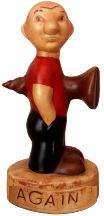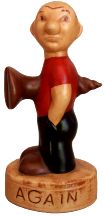 |
 The Virtual Corkscrew Museum's Weekly Newspaper |
 |
 |
 The Virtual Corkscrew Museum's Weekly Newspaper |
 |
|
Sunday, August 16, 2009 |
Number 570 |
Hamilton Estabrook's Patent
Editor's note: In 1888 George P. Wittlesey wrote "Ham Estabrook's Can- Opener". It was a lengthy story going into many details of Ham's life, his inventions, his frustrations, and his success. I have condensed and edited the story so you can briefly take a look at the process he went through to patent his combination can opener and corkscrew.
When Hamilton "Ham" Estabrook was in the junior class of his school in Maine, he considered getting a job for the summer to start raising money for college. His father suggested he invent something, get a patent, and sell it for enough for college expenses. When his father complained about the unreliability of a pumping engine at the paper mill where he worked, Ham worked on some ideas and made some drawings. When he presented them to the foreman at the mill, he learned that it had already been done with disappointing results. A few days later, he visited the local railroad station and heard about problems with car couplers. Again he drew and this time he learned that someone had already done a scientific paper that was quite similar. Next he discussed an idea with his geography teacher to help students learn about the states. He made a puzzle map with cutouts of each state. When he presented it to the schoolmaster, he was discouraged to learn that it had already been done. He gave up inventing and took a summer job in a hardware store.
One day Bessie McAllister came into the store. She was going on a picnic and for convenience was looking for a combination can opener and corkscrew. She thought it would be very handy tool. Ham looked high and low in the store and didn't find one. The picnic was the following week. Ham went home and began to make some sketches. After dinner, he went to work building a wood model. The next day, Ham's father took the model to a local foundry and had a few handles cast. In time for the picnic, Ham presented Bessie with his invention. Bessie was in awe and suggested he consult her cousin Joe Stanwood about getting a patent. He went home and packaged up a model with this message:
Ham anxiously awaited the response with frequent stops at the Post Office. Ham was disappointed when this message arrived:
The note was accompanied with a pamphlet entitled "Rules of Practice in the United State Patent Office. Revised December 1, 1879." There were fifty pages of rules. He contacted Joe Stanwood who explained to him he needed a petition or application, a specification or description, an oath, a drawing, and a fee for the patent examiner. Ham was a bit taken aback when he learned the non-refundable application fee was $15. He couldn't afford it. Bessie's brother Tom McAllister was a friend of Joe and Ham. When he heard about this dilemma, he offered to advance the money for shares of the profits when the patent sold. Ham sat down with Joe and Tom to prepare the necessary papers. First came the petition:
The lengthy specification was written with references to figure numbers and letters in Ham's sketches. This was followed by claims:
…and the Oath:
A mechanical draftsman was engaged to make the official drawing measuring ten by 15 inches. The papers were signed and sent to the Commissioner of patents with this letter:
The Commissioner of Patents office responded with a "receipt":
An assistant examiner was assigned to the case and searched drawings in the patent class "Household Articles: corkscrews" as well as all related English, French, and German patents. The assistant also did a thorough search of "compound Tools" and "can-openers." Within a few days this message was sent to Joe Stanwood:
Here are the drawings of the patents referenced:
After careful investigation, Joe told Ham they should erase the rejected claims and secure the patent based on the other claims. Ham was growing more and more discouraged while Joe explained how these things can happen during a review. On July 18, they sent this brief message:
The amendments was received and recorded in the patent office under "case number 13,133." The assistant carefully studied the papers, signed off on them, and sent the model to the Model Halls for safe keeping. This communication was then mailed:
Joe reminded Tom of the promise to advance all monies due. Tom agreed, the funds were sent and about four weeks later, Ham was delighted to receive a package containing a document with blue ribbons and red seals. The steel engraved document was:
A photo lithograph of the drawing and a printed copy of the specification were included. Joe asked Ham if he had any plans for selling the patent or manufacturing his invention. Obviously, Ham had never gone that far and he asked Joe for suggestions. Joe suggested consulting Tom McAllister who already had an investment in the affair and could be looking for ways to get his money back. Ham wrote to Tom who was now in Boston and after several weeks he got letters from Tom that were not very encouraging. He claimed there were many patents on the market and manufacturers did not foresee a good demand for Ham's invention.
A short time later, Ham's father had an accident at the mill was laid up. The family would now have to depend on Ham to support and he would have to give up thoughts of college. Ham went to see the mill superintendent claiming the accident should not have happened if proper precautions had been in place. As a result, he secured for himself a job paying fifty dollars per month. His mother was pleased but still felt an obligation to Tom for the money he had invested in the "invention." Few days later he received a note from Tom:
Ham agreed to take his share of the two thousand dollars and once again made plans to go to college. His combination can opener and corkscrew had saved the day!
****************************************************************
Notes:
Shortly after the above events, this notice was posted at the United States Patent Office:
Subsequent to authoring "Ham Estabrook's Can- Opener," George P. Wittlesey applied for and was granted several patents between 1890 and 1905. They were not for corkscrews or can openers.
The illustration on the cover of the BST was done by H. A. Ogden to accompany Wittlesey's account. Bessie is holding Ham's combination can opener/corkscrew and asking "Did you really make this?"
****************************************************************
Editor's note: I submitted this article to The Bottle Scrue Times, the newsletter of the International Correspondence of Corkscrew Addicts (ICCA). It appeared there first in the Spring 2009 issue.
|
©2009 Don Bull, Editor |